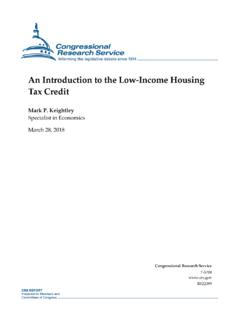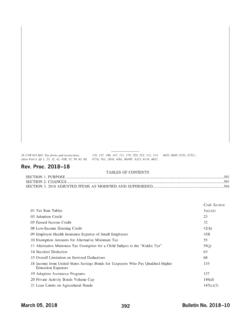Transcription of State of Delaware Low Income Housing Tax Credit Qualified ...
1 State of Delaware Low Income Housing Tax Credit Qualified Allocation Plan January 11, 2018. Delaware State Housing Authority 18 The Green Dover, DE 19901. John Carney, Governor Anas Ben Addi, Director Contents Introduction .. 3. Program Approval .. 5. DSHA Policy on Civil Rights Compliance .. 5. The Delaware Freedom of Information Act .. 6. 6. Description of Housing Needs and Priorities .. 18. Housing Needs and 18. Preservation of Existing Assisted Affordable Housing .. 18. Needs of People with Disabilities and Special Populations .. 19. New Creation of Affordable Rental Housing .. 19. Tax Credit Allocations and Pools .. 21. Estimated Dollar Amounts for 2018 .. 21. Nonprofit Pool .. 21. Preservation/Rehabilitation 22. New Housing Creation Pool .. 23. General Application 23.
2 Application Process .. 23. Technical Assistance Meetings Available to all LIHTC Applicants .. 24. Cure Period .. 24. Application Fees and Processing .. 25. DSHA Fees, Rates and Term Schedule .. 26. Tax-Exempt Bond-Financed Developments .. 26. Tax-Exempt Revenue Bond Fees .. 27. Threshold Requirements .. 27. Scoring and Ranking .. 36. General Information .. 36. DEVELOPMENT CHARACTERISTICS 50 possible points .. 37. COMMUNITY IMPACT 50 possible points .. 41. TENANT POPULATIONS SERVED 45 possible points .. 45. USE OF RESOURCES 40 possible points .. 48. 1 of 70. DEVELOPMENT TEAM 25 possible points .. 51. BONUS POINTS .. 53. Scoring 54. 55. REVIEW AND SELECTION PROCESS .. 55. State Basis 55. Preliminary Ranking Notifications, Appeals and Unused Credits .. 56. Forward Commitments.
3 57. Post Tax Credit Award Requirements .. 58. DECLARATION OF RESTRICTIVE COVENANTS .. 58. Placed in Service 58. Non-Compliance with Placed in Service Date Forward Reservation .. 59. Cost Certification .. 60. Post Tax Credit Award Documents .. 62. Compliance Monitoring Procedures .. 63. Initial Review .. 63. Subsequent Review .. 63. Inspections .. 64. Data 64. Minimum Low Income Set Aside .. 64. Rent 65. Income Requirement .. 65. Recordkeeping Requirements .. 65. Annual Project Certification and Review .. 67. Notice to Owner .. 68. Notice to Internal Revenue Service .. 68. Correction Period .. 69. Compliance Monitoring Fee .. 69. Compliance Monitoring Manual .. 69. 2018 Application Checklist for Low Income Housing Tax 70. 2 of 70. Introduction The Federal Low Income Housing Tax Credit (LIHTC) program was established by section 252 of the Tax Reform Act of 1986 and was codified as section 42 of the Internal Revenue Code of 1986 as amended (IRC).
4 The Revenue Reconciliation Act of 1989 amended IRC section 42 by adding section 42(m) that requires allocating agencies to allocate low- Income Housing tax credits pursuant to a Qualified Allocation Plan (QAP). The Delaware State Housing Authority (DSHA) is the allocating agency for the State of Delaware . The following QAP represents the standards and procedures used by DSHA to perform its allocation and monitoring responsibilities. section 42(m) of the IRC states: For purposes of this paragraph, the term Qualified Allocation Plan means any plan: i) Which sets forth selection criteria to be used to determine Housing priorities of the Housing Credit agency that is appropriate to local conditions. ii) Which also gives preference in allocating Housing Credit dollar amounts among selected projects to: a) Projects serve the lowest- Income tenants.
5 B) Projects serve Qualified tenants for the longest periods; and c) Projects which are located in Qualified Census tracts and the development of which contributes to a concerted community revitalization plan. iii) Which provides a procedure that the Agency (or an agent or other private contractor of such agency) will follow in monitoring for noncompliance with the provisions of this section and in notifying the Internal Revenue Service of noncompliance with the provisions of this section which such agency becomes aware of and in monitoring for noncompliance with habitability standards through regular site visits. Certain selection criteria must be used. The selection criteria set forth in a QAP must include: a) Project location;. b) Housing needs characteristics;. c) Project characteristics, including whether the project includes the use of existing Housing as part of a community revitalization plan.
6 D) Sponsor characteristics;. e) Tenant populations with special needs Housing ;. f) Public Housing waiting lists;. g) Tenant populations of individuals with children;. h) Projects intended for eventual tenant ownership;. i) Energy efficiency; and j) Preserving historic character. The LIHTCs may be claimed annually for ten (10) years by owners of, or investors in, Qualified low- Income rental Housing . The maximum amount of annual Credit is based on the depreciable costs of development, the number of Qualified low- Income units, the Credit percentage rate, and the amount needed to make the development viable. The annual Credit amount is determined at the time of final allocation and remains constant for the entire ten (10)-year period. 3 of 70. Eligible developments include new construction, substantial rehabilitation and acquisition, (if a substantial rehabilitation is being undertaken).
7 The maximum Credit percentage for qualifying costs in an eligible development is 9% for competitive new construction or rehabilitation costs awarded pursuant to the annual tax Credit volume cap. The maximum tax Credit percentage for costs associated with acquisition or with federally-subsidized projects, including tax-exempt bond projects, is calculated monthly based on the applicable rate issued by the Treasury Department. DSHA will underwrite and allocate acquisition credits based on the applicable rate issued by the Treasury Department one (1) month prior to application submission and will utilize an equity factor dictated by market conditions. The equity factor will be listed in the application. If a development fails to meet the minimum eligibility requirements at any time during the compliance period, the "accelerated" Credit amount, plus interest, may be subject to recapture by the IRS.
8 The federal government considers the Credit a fifteen (15)-year benefit accelerated to ten (10) years. Therefore, the accelerated Credit amount is the difference between the aggregate amount of Credit claimed and the aggregate amount of Credit that would have been available if the Credit was spread over the entire fifteen (15)-year period. The LIHTC Program is complex and evolving. Changes in the program adopted by Congress over the life of the program require careful review even by persons who have extensive experience and expertise with this program and its requirements. The explanation contained in this QAP is Qualified in its entirety, as it is only a summary of the LIHTC program and should not in any way be relied upon as legal advice. To that end, it is strongly recommended that project sponsors and applicants interested in applying for a tax Credit allocation contact their tax accountant and attorney to review this program, the IRC and IRS.
9 Regulations, IRS rulings, IRS guidance, and any other pertinent information before pursuing the program. As rules and regulations continue to be issued by the Department of Treasury for all facets of the LIHTC Program, tax Credit Preliminary Reservations and Allocations will be made by DSHA based on existing regulations. Any changes of rules and requirements must be met by the owner/investor(s) in order for them to continue receiving the tax Credit . Regulations, rulings, Revenue Procedures, and Technical Advice Memoranda (TAM) are regularly issued by the IRS. It is the sponsor's/applicant's obligation to understand and comply with the rules. DSHA encourages all applicants to promote greater choice of Housing opportunities and avoid undue concentration of assisted persons in areas containing a high proportion of low- Income residents or in areas containing a high proportion of affordable rental units and build communities of opportunities for newly- created (conversion or new construction) projects.
10 DSHA also encourages all applicants to consider building in communities with minimal affordable rental units relative to their Housing needs for newly- created affordable Housing projects. Failure of a project to fulfill all representations made in its application may result in a delay and/or non- issuance of the IRS Form 8609. At its sole discretion, DSHA may impose penalties for failure to comply with eligibility or point requirements. Such penalties may include, but will not be limited to, a reduction in the allocated Credit amount, the unilateral cancellation of an allocation, or penalty points which will be carried forward to applicant's subsequent DSHA LIHTC application. 4 of 70. Program Approval In accordance with LIHTC regulations, the allocation plan must be approved by the Governor of the State before credits can be allocated.







